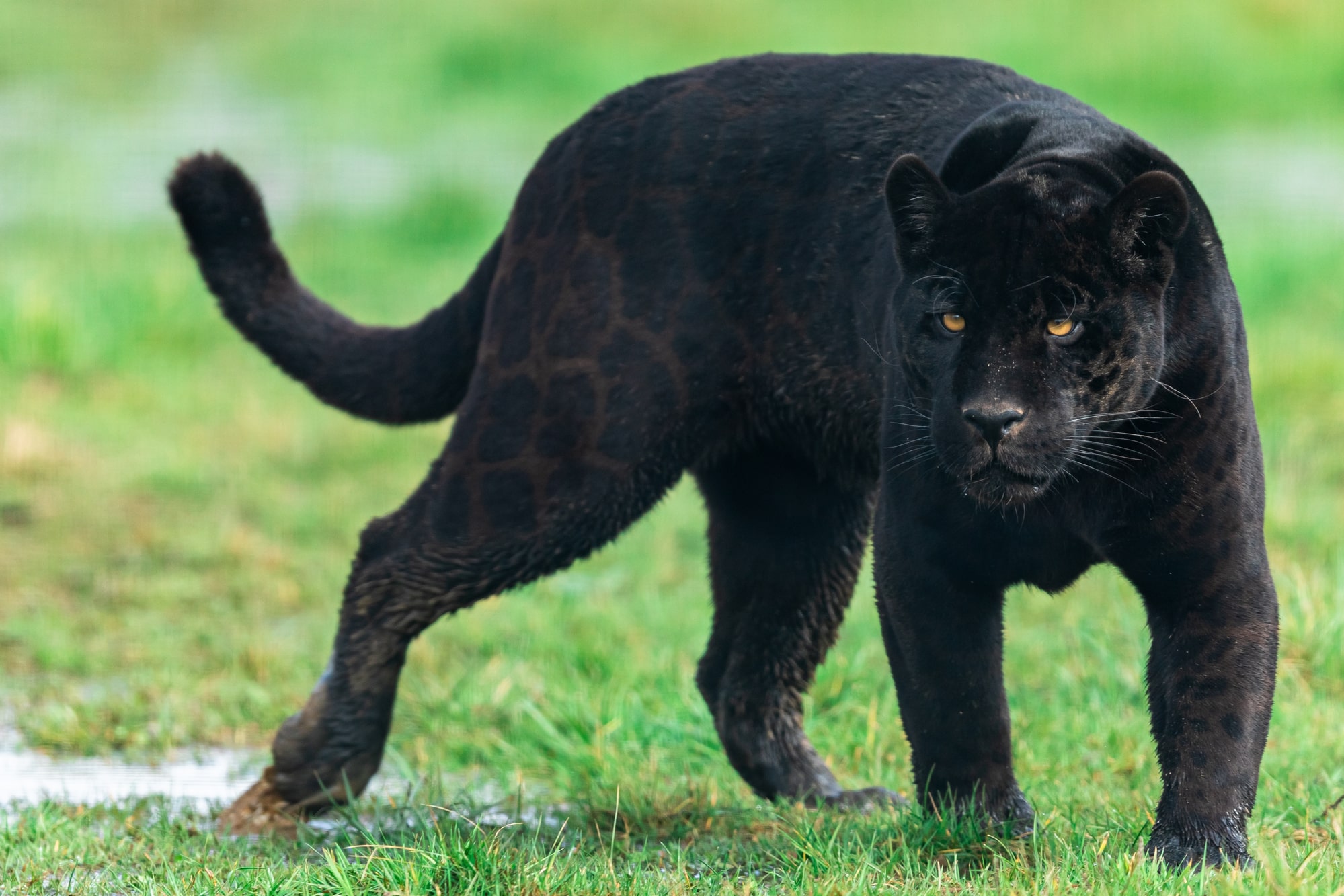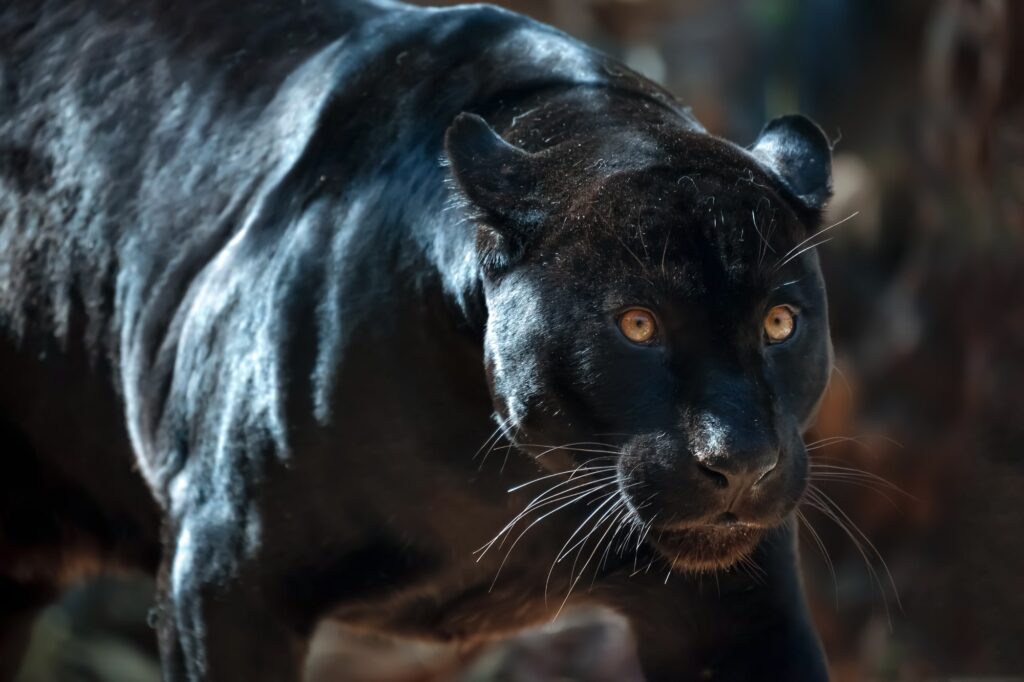Are you ready to discover the secrets of the mysterious panther? This article has all the fascinating facts you need to know about their appearance, behavior, and conservation status.
From their sleek black coats to their lightning-fast speed, panthers are truly remarkable creatures.
You’ll also uncover the truth behind common misconceptions and explore the efforts being made to protect these endangered animals.
Whether you’re an animal lover or just curious, get ready to immerse yourself in the captivating world of panthers.
Classification of Panthers
When it comes to the classification of panthers, it’s important to understand their place within the panthera genus.
Panthers, also known as black leopards or black jaguars, are the melanistic color variant of these species. Melanism is caused by a recessive allele in leopards and deletions in the melanocortin 1 receptor gene in jaguars.
Black panthers have been recorded in various regions around the world, including India, Kenya, Malaysia, Thailand, and Costa Rica. In India, they’ve been observed in the Western Ghats area of Maharashtra and Karnataka.
Panthers have a wide range of habitats, including forests, grasslands, and mountainous regions.
Understanding their classification helps us appreciate the unique characteristics and distribution of these fascinating creatures.

The Panther’s Habitat
The Panther’s Habitat is crucial to their survival and plays a vital role in their ecological niche.
Panthers prefer dense vegetation in locations such as mountain ranges, tropical forests, wetlands, and savannahs. These habitats provide the necessary cover and resources for them to thrive.
However, human development and habitat destruction pose significant threats to their survival. As their habitat is reduced, panthers face challenges in finding enough land to expand their territories and secure sufficient prey. Highways and fragmented landscapes also disrupt their natural movement patterns.
Conservation efforts are crucial in protecting and preserving the panther’s habitat to ensure their long-term survival and maintain the balance of ecosystems they inhabit.
Facts About the Diet of Panthers
To understand the diet of panthers, it’s important to recognize that these magnificent creatures primarily hunt at night, using their excellent eyesight and sense of smell to locate and capture their prey. Panthers are carnivorous and prey upon small to medium-sized herbivores. Their diet mainly consists of animals such as deer, wild boar, rabbits, and rodents.
They’re opportunistic hunters and will also feed on birds, reptiles, and fish when available. Panthers are skilled hunters and often rely on stalking and ambushing their prey. They’ve strong jaws that enable them to take down and drag their catch.
With their stealthy hunting techniques and powerful physique, panthers are well-equipped to sustain themselves in their natural habitats.
Panther Adaptability
To understand the adaptability of panthers, consider their remarkable ability to thrive in diverse environments and overcome various challenges.
Panthers have shown incredible resilience in adapting to different habitats, ranging from dense forests to open grasslands.
They’ve the flexibility to hunt both on the ground and from trees, utilizing their strong climbing skills to their advantage.
Panthers’ dark fur not only helps them camouflage in their surroundings but also provides protection from the elements.
Their excellent eyesight and sense of smell enable them to locate prey efficiently, while their speed and strength allow them to chase down and capture their targets.
Despite human development and habitat loss, panthers have managed to survive and even expand their territories.
Their adaptability is a testament to their ability to overcome adversity and thrive in a changing world.
Panther Species Facts
Discussing Panther Species Facts, you’ll find interesting information about different types of panthers and their unique characteristics.
Panthers, also known as black leopards or black jaguars, are the melanistic color variant of these species. The black coat is caused by a recessive allele in leopards and deletions in the melanocortin 1 receptor gene in jaguars.
Black panthers have been recorded in various regions around the world, including India, Kenya, Malaysia, Thailand, and Costa Rica. They’ve a wide range of habitats, including forests, grasslands, and mountainous regions.
Black panthers exhibit similar behavior and ecological traits to their non-melanistic counterparts, being solitary and primarily active during the night.
The conservation of black panthers is crucial due to their rarity and the threats they face from habitat destruction, fragmentation, and poaching.
Facts About the Size of Panthers
Now let’s look into the fascinating world of panthers and explore some intriguing facts about their size.
Panthers are known for their impressive size, with adult males typically weighing between 100 and 160 pounds. Females are slightly smaller, weighing between 70 and 100 pounds. These majestic creatures can grow up to 6 to 7 feet in length from nose to tail.
Panthers have a muscular build and are known for their agility and strength, allowing them to navigate through their dense habitats with ease. Their powerful limbs and sharp claws enable them to climb trees, providing them with a vantage point for hunting and resting.
Facts About Their Communication
You can learn a lot about panthers by understanding how they communicate with each other and their environment. Panthers use a variety of vocalizations to communicate, including growls, hisses, and screams. These vocalizations help them establish territories, attract mates, and warn off potential threats.
Panthers also communicate through body language, using their tails, ears, and facial expressions to convey different messages. For example, a raised tail indicates aggression, while flattened ears signal submission.
Panthers also use scent marking to communicate. They have scent glands located on their cheeks, chin, and tail, which they use to mark their territory and communicate their presence to other panthers.
Hunting Techniques
By understanding how panthers communicate, you can gain insight into their behavior and social interactions, which extends to their hunting techniques.
Panthers are skilled hunters and employ various techniques to capture their prey. They’re primarily nocturnal hunters, using their excellent eyesight and sense of smell to locate their targets.
Panthers are known for their stealth and agility, allowing them to silently stalk their prey before launching a swift and powerful attack. They often rely on their dark fur to blend into their surroundings, camouflaging themselves until the perfect moment to strike.
Panthers primarily hunt on the ground, using their speed and strength to chase down their prey. However, they’re also capable of ambushing their prey from trees, utilizing their climbing abilities and strong jaws to drag their catch into the branches.
Panther Reproduction
Panther Reproduction involves the process of mating and the subsequent birth and care of panther cubs. The gestation period for a female panther is around 3 months. After this period, the female gives birth to the cubs in a safe den. The male panther doesn’t play a part in raising the cubs.
Panther cubs stay with their mother for almost 2 years and start hunting after 2-3 months. During this time, the mother provides care and protection for her cubs. Panther reproduction is a crucial aspect of their survival and conservation efforts. By ensuring successful mating and the growth of healthy cubs, the panther population can be sustained and protected for future generations.
The Lifespan of Panthers
Panthers typically have a lifespan of around 10 to 15 years in the wild. This range can vary depending on various factors such as diet, habitat, and overall health.
In captivity, where they’re protected from natural threats and have access to proper healthcare, panthers can live longer, with some individuals reaching their late teens or even early twenties.
However, in the wild, panthers face numerous challenges that can affect their lifespan. These challenges include competition for resources, predation, diseases, and habitat loss due to human activities.
Additionally, factors such as hunting and poaching can also contribute to the decline of panther populations and shorten their lifespan.
Efforts to conserve and protect panthers and their habitats are essential for ensuring their survival and increasing their lifespan in the wild.
Facts About Panther Senses
When encountering a panther, you should be aware of its keen senses and how they play a crucial role in its survival.
Panthers have excellent eyesight, allowing them to spot prey from a distance. Their vision is especially acute in low light conditions, making them skilled hunters at night.
In addition to their sharp eyesight, panthers also possess a highly developed sense of hearing. They can detect even the slightest rustle or movement, helping them locate prey or avoid potential threats.
Furthermore, their sense of smell is incredibly powerful, enabling them to track scents over long distances.
These heightened senses allow panthers to navigate their environment, hunt effectively, and stay alert to ensure their survival in the wild.
Panther Conservation Status
As we look further into the conservation status of panthers, it’s important to understand the current challenges they face in their struggle for survival.
Panthers are now considered endangered due to habitat destruction, fragmentation, and poaching. Their rarity and ecological significance make their conservation crucial. Human activity, such as hunting for fur and trophies, has caused a decline in their numbers.
The reduction of their habitat is also a significant threat to their survival. Panthers need more land to expand, but human development and highways pose challenges. Efforts are being made to increase the population of panthers in Florida, with the goal of having three separate populations of roughly 230 panthers each throughout the state.
However, the conservation of panthers still remains a critical issue.
Threats to Panthers
To understand the challenges faced by panthers, it’s important to recognize the threats they encounter in their struggle for survival. Panthers face various threats that put their population at risk.
One of the main threats is habitat loss due to human development. As more land is cleared for agriculture, urbanization, and infrastructure, the available habitat for panthers diminishes. This fragmentation of their habitat makes it difficult for them to find food, mates, and establish territories.
Another significant threat is road mortality. Panthers often get hit by vehicles while attempting to cross busy roads, resulting in fatalities.
In addition, illegal hunting and poaching pose a serious threat to panther populations. These activities target panthers for their fur and body parts, further depleting their numbers.
Climate change is also a growing concern, as it alters the availability of resources and disrupts their natural habitat.
It’s crucial to address these threats and implement conservation measures to ensure the survival of these magnificent creatures.
Range
Panthers have a wide range of habitats, including forests, grasslands, and mountainous regions. They’re adaptable creatures that can thrive in various environments.
Panthers can be found in tropical rainforests, where the dense vegetation provides ample cover for hunting and hiding. They also inhabit grasslands, where they can easily spot and chase down their prey. In mountainous regions, panthers use their agility and climbing skills to navigate rocky terrains.
This diverse range of habitats allows panthers to survive and thrive in different ecosystems. However, human activities such as deforestation and urbanization pose a threat to their habitat, leading to a decrease in their range.
Conservation efforts are crucial to protect and preserve the habitats of these magnificent creatures.
Panther Behavior
When it comes to Panther behavior, their solitary nature is a defining trait that influences their hunting and social interactions. Panthers are solitary animals, preferring to live, hunt, and travel alone. They only socialize during the mating season, when the female leaves scent markings and makes a sawing sound to attract the male. After mating, the pair rarely stays together for more than a few days.
Panthers are carnivorous and rely on their solitary hunting behavior to survive. They hunt primarily at night, using their excellent eyesight and sense of smell to locate prey. Panthers are skilled hunters on the ground but can also ambush prey from trees.
Their solitary nature allows them to efficiently hunt and secure their food sources.
Facts About Their Social Structure
Panthers maintain a solitary lifestyle, preferring to live, hunt, and travel alone. They aren’t social animals and don’t form packs or prides like some other big cats. The only time they interact with each other is during the mating season.
Females attract males by leaving scent markings and making a distinct sawing sound. After mating, the pair typically separates within a few days.
Panthers are highly territorial and mark their territories with scent markings as a way to communicate with other individuals. They’ve large home ranges and avoid overlapping with other panthers.
This behavior helps minimize competition and ensures that they’ve enough resources to survive in their habitat.
Panther Vocalizations
During the mating season, as panthers interact with each other, they use a variety of vocalizations to communicate. These vocalizations serve different purposes, such as attracting potential mates and establishing territory.
Male panthers emit low-pitched roars to announce their presence and assert dominance. These roars can travel long distances, allowing other panthers to hear them from afar.
Females, on the other hand, produce high-pitched screams and moans to signal their availability and to attract males.
The vocalizations of panthers are powerful and distinct, reflecting their strength and intensity.
Panther Mythology
Mythology surrounding panthers includes various cultural beliefs and legends. In ancient European mythologies, panthers were depicted as multi-colored beasts with unique characteristics. These creatures were often associated with power, strength, and mystery. Panthers were believed to possess the ability to shape-shift into other animals, such as birds or snakes, and were considered guardians of the spirit world.
In Native American folklore, panthers were revered as symbols of courage and spiritual guidance. They were seen as protectors and were believed to possess supernatural abilities. Panthers were also associated with the moon and were thought to have a deep connection to the night and the mysteries it held.
These myths and legends have contributed to the enduring fascination and respect for panthers in various cultures around the world.
Cultural Significance
In various cultures around the world, panthers hold a significant place in the collective imagination. These majestic creatures have long been associated with qualities such as power, strength, and agility.
In many ancient mythologies, panthers were revered as symbols of royalty and authority, often depicted alongside gods and goddesses. They were seen as guardians and protectors, embodying both grace and ferocity.
Panthers have also made their way into popular culture, becoming iconic figures in art, literature, and even sports. Their sleek black coats and piercing eyes evoke a sense of mystery and allure, captivating our imagination.
Whether seen as mystical beings or embodiments of natural prowess, panthers continue to be celebrated and revered in various cultural traditions around the world.
Conservation Efforts
To protect and preserve the dwindling population of panthers, conservation efforts have been implemented. These efforts aim to address the threats facing panthers and ensure their survival in the wild.
One of the main strategies is habitat conservation, which involves protecting and restoring their natural habitats. This includes establishing protected areas, such as wildlife reserves and national parks, where panthers can thrive without human interference.
Additionally, conservationists work to reduce conflicts between panthers and humans by implementing measures like improved livestock management and creating wildlife corridors to allow panthers to move freely between fragmented habitats.
Public awareness and education programs are also important in promoting panther conservation and encouraging people to take actions to support their survival.
Through these efforts, we can help secure a future for these majestic creatures and maintain the balance of our ecosystems.





